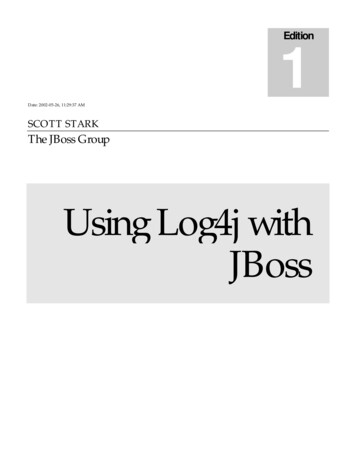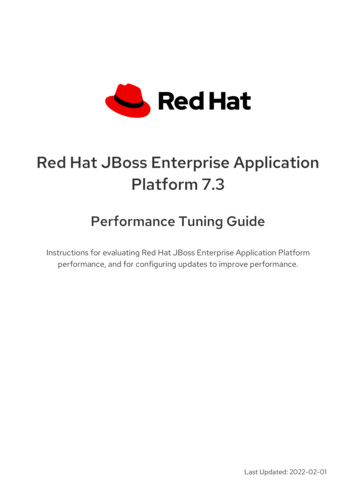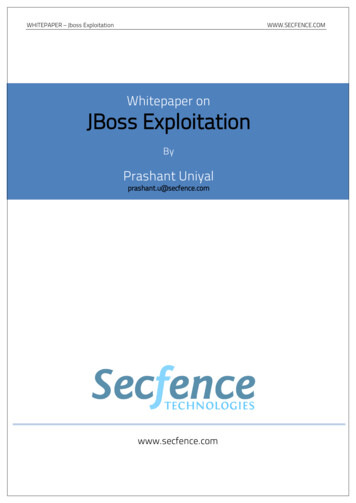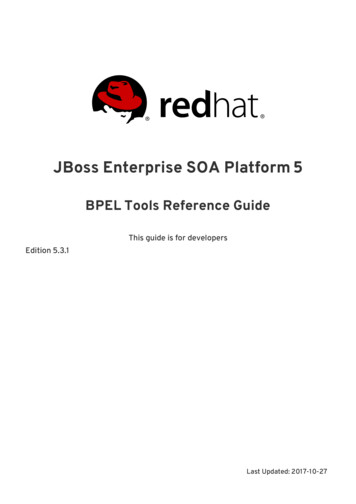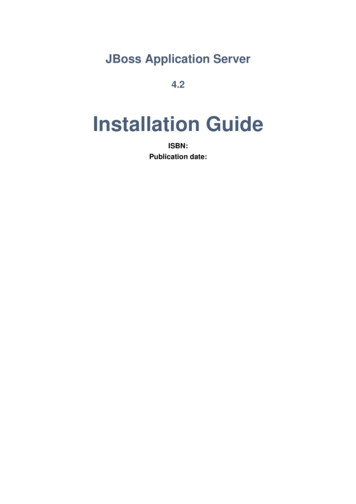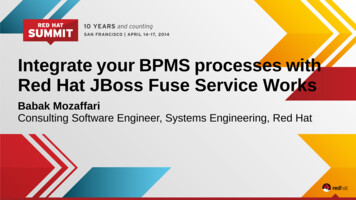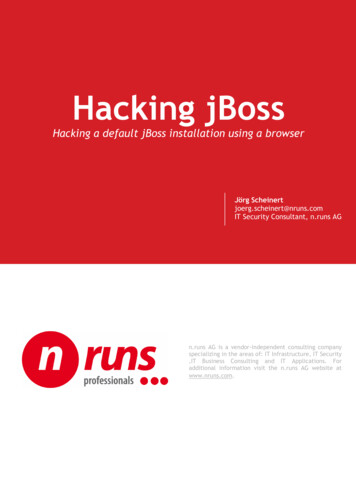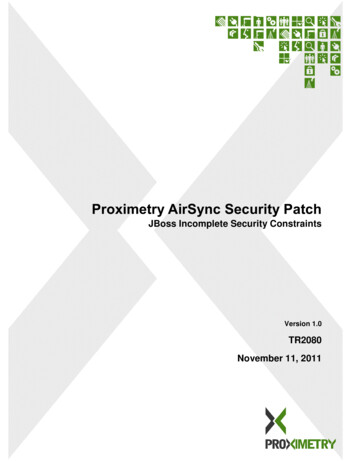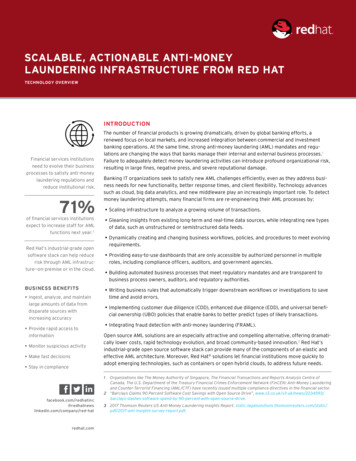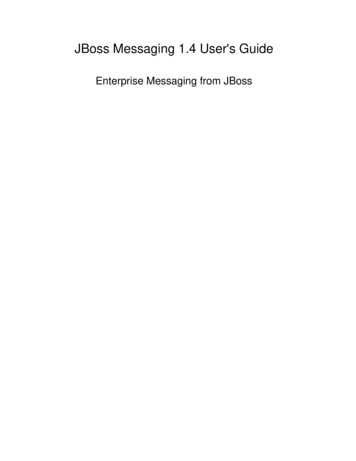
Transcription
JBoss Messaging 1.4 User's GuideEnterprise Messaging from JBoss
Table of Contents1. About JBoss Messaging 1.4.0. .12. Introduction .22.1. JBoss Messaging support cover from Red Hat .22.2. JBoss Messaging Features .22.3. Compatibility with JBossMQ .43. Download Software .53.1. SVN Access .54. JBoss Messaging Installation .64.1. Installing JBoss Messaging on JBoss AS 4.2 .64.1.1. Automated Installation .64.1.2. Manual Installation .94.1.3. Extra steps to complete your installation .124.2. Starting the Server .144.3. Installation Validation .164.4. Accessing JBoss Messaging from a remote client .175. Running the Examples .196. Configuration .216.1. Configuring the ServerPeer .216.1.1. ServerPeer attributes .236.1.1.1. ServerPeerID .236.1.1.2. DefaultQueueJNDIContext .236.1.1.3. DefaultTopicJNDIContext .236.1.1.4. PostOffice .236.1.1.5. SecurityDomain .236.1.1.6. DefaultSecurityConfig .236.1.1.7. DefaultDLQ .246.1.1.8. DefaultMaxDeliveryAttempts .246.1.1.9. DefaultExpiryQueue .246.1.1.10. DefaultRedeliveryDelay .246.1.1.11. MessageCounterSamplePeriod .246.1.1.12. FailoverStartTimeout .246.1.1.13. FailoverCompleteTimeout .246.1.1.14. DefaultMessageCounterHistoryDayLimit .256.1.1.15. ClusterPullConnectionFactory .256.1.1.16. DefaultPreserveOrdering .256.1.1.17. RecoverDeliveriesTimeout .256.1.1.18. SuckerPassword .256.1.1.19. StrictTCK .256.1.1.20. Destinations .256.1.1.21. MessageCounters .256.1.1.22. MessageCountersStatistics .266.1.1.23. SupportsFailover .266.1.1.24. PersistenceManager .266.1.1.25. JMSUserManager .26ii
JBoss Messaging 1.4 User's Guide6.1.1.26. We now discuss the MBean operations of the ServerPeer MBean. .266.2. Changing the Database .286.3. Configuring the Post office .286.3.1. The post office has the following attributes .316.3.1.1. DataSource .316.3.1.2. SQLProperties .316.3.1.3. CreateTablesOnStartup .316.3.1.4. PostOfficeName .316.3.1.5. NodeIDView .316.3.1.6. GroupName .316.3.1.7. Clustered .326.3.1.8. StateTimeout .326.3.1.9. CastTimeout .326.3.1.10. MaxConcurrentReplications .326.3.1.11. ControlChannelConfig .326.3.1.12. DataChannelConfig .326.4. Configuring the Persistence Manager .326.4.1. We now discuss the MBean attributes of the PersistenceManager MBean .346.4.1.1. CreateTablesOnStartup .346.4.1.2. UsingBatchUpdates .356.4.1.3. UsingBinaryStream .356.4.1.4. UsingTrailingByte .356.4.1.5. SupportsBlobOnSelect .356.4.1.6. SQLProperties .356.4.1.7. MaxParams .356.5. Configuring the JMS user manager .366.5.1. We now discuss the MBean attributes of the JMSUserManager MBean .366.5.1.1. CreateTablesOnStartup .366.5.1.2. UsingBatchUpdates .366.5.1.3. SQLProperties .366.6. Configuring Destinations .376.6.1. Pre-configured destinations .376.6.2. Configuring queues .396.6.2.1. We now discuss the attributes of the Queue MBean .396.6.2.2. We now discuss the MBean operations of the Queue MBean .426.6.3. Configuring topics .436.6.3.1. We now discuss the MBean attributes of the Topic MBean .436.6.3.2. We now discuss the MBean operations of the Topic MBean .456.7. Configuring Connection Factories .466.7.1. We now discuss the MBean attributes of the ConnectionFactory MBean .486.7.1.1. ClientID .486.7.1.2. JNDIBindings .486.7.1.3. PrefetchSize .486.7.1.4. SlowConsumers .486.7.1.5. StrictTck .486.7.1.6. Temporary queue paging parameters .486.7.1.7. DupsOKBatchSize .486.7.1.8. SupportsLoadBalancing .486.7.1.9. SupportsFailover .49iii
JBoss Messaging 1.4 User's Guide6.7.1.10. DisableRemotingChecks .496.7.1.11. LoadBalancingFactory .496.7.1.12. Connector .496.8. Configuring the remoting connector .506.9. ServiceBindingManager .527. JBoss Messaging Clustering Notes .537.1. Unique server peer id .537.2. Clustered destinations .537.3. Clustered durable subs .537.4. Clustered temporary destinations .537.5. Non clustered servers .537.6. Message ordering in the cluster .547.7. Idempotent operations .547.8. Clustered connection factories .548. JBoss Messaging XA Recovery Configuration .559. JBoss Messaging Message Bridge Configuration .579.1. Message bridge overview .579.2. Bridge deployment .589.3. Bridge configuration .589.3.1. SourceProviderLoader .609.3.2. TargetProviderLoader .609.3.3. SourceDestinationLookup .609.3.4. TargetDestinationLookup .609.3.5. SourceUsername .619.3.6. SourcePassword .619.3.7. TargetUsername .619.3.8. TargetPassword .619.3.9. QualityOfServiceMode .619.3.10. Selector .619.3.11. MaxBatchSize .619.3.12. MaxBatchTime .629.3.13. SubName .629.3.14. ClientID .629.3.15. FailureRetryInterval .629.3.16. MaxRetries .629.3.17. AddMessageIDInHeader .62iv
1About JBoss Messaging 1.4.0.JBoss Messaging is the new enterprise messaging system from JBoss. It is a complete rewrite of JBossMQ, the legacy JBoss JMS provider.JBoss Messaging will be the default JMS provider in later versions of JBoss Enterprise Application Platform, andJBoss Service Integration Platform. It will also be the default JMS provider in JBoss Application Server 5, and isthe default JMS provider for JBoss ESB.JBoss Messaging is an integral part of Red Hat's strategy for messaging.Compared with JBossMQ, JBoss Messaging offers improved performance in both single node and clustered environments.JBoss Messaging also features a much better modular architecture that will allow us to add more features in the future.JBoss Messaging can be easily installed in JBoss Application Server 4.2 using a few simple steps to remove JBossMQ and replace with JBoss Messaging.Once JBoss Messaging becomes the default JMS provider in JBoss Application Server, there will be no need to doany manual installation.From release 1.4.0. onwards JBoss Messaging is designed for JBoss 4.2 only and is Java 5.The procedure of installing JBoss Messaging into JBoss Application Server is detailed in this p://www.jboss.org/index.html?module bb&op viewforum&f 238].JBossMessaginguserforumPermanent Team: Tim Fox (Project Lead), Jeff Mesnil (Core Developer), Andy Taylor (Core Developer), ClebertSuconic (Core Developer)Contributors: Ovidiu Feodorov (Project Founder), Sergey Koshcheyev, Ron Sigal, Madhu Konda, Jay Howell, Tyronne Wickramarathne, Aaron Walker, Adrian Brock, Rajdeep Dua, Tom Elrod, Alex Fu, Juha Lindfors, AlexeyLoubyansky, Luc Texier, Scott Stark, Aslak KnutsenMessaging support team: Jay Howell, David Boeren, Mike Clark, Tyronne WickramarathneOther thanks to: Mark Little and Pete Bennett1
2IntroductionJBoss Messaging provides an open source and standards-based messaging platform that brings enterprise-classmessaging to the mass market.JBoss Messaging implements a high performance, robust messaging core that is designed to support the largest andmost heavily utilized SOAs, enterprise service buses (ESBs) and other integration needs ranging from the simplestto the highest demand networks.It will allow you to smoothly distribute your application load across your cluster, intelligently balancing and utilizing each nodes CPU cycles, with no single point of failure, providing a highly scalable and performant clusteringimplementation.JBoss Messaging includes a JMS front-end to deliver messaging in a standards-based format as well as being designed to be able to support other messaging protocols in the future.JBoss Messaging is destined to become an integral part of the JBoss Enterprise Application Platform, and the newService Integration Platform.Currently it is available for embedded use within the JBoss Application Server 4.2.0.GA or later (JBossAS). Workto integrate JBoss Messaging with the new JBoss Microcontainer is under way.JBoss Messaging is also an integral part of Red Hat's strategy for messaging. JBoss Messaging is committed toAMQP ( AMQP [http://www.amqp.org])- the new messaging standard from Red Hat and others. Later versions ofJBoss Messaging will support AMQP, and JBoss Messaging will be focussed on becoming the premier AMQPJava broker.2.1. JBoss Messaging support cover from Red HatJBoss Messaging is destined to become part of both Application Server Platform and Service Integration Platformas default JMS provider.Production support will then be fully available for these plaforms and it will cover JBossMessaging.There is a currently an early adopters program where production support is given for JBoss Messaging. Applications are considered on a case-by-case basis.Currently developer support is generally available for JBoss Messaging when installed in JBoss 4.2.x2.2. JBoss Messaging FeaturesJBoss Messaging provides:2
Introduction A fully compatible and Sun certified JMS 1.1 implementation, that currently works with a standard 4.2 or laterJBoss Application Server installation. A strong focus on performance, reliability and scalability with high throughput and low latency. A foundation for JBoss ESB for SOA initiatives; JBoss ESB uses JBoss Messaging as its default JMS provider.Other JBoss Messaging features include: Publish-subscribe and point-to-point messaging models Persistent and non-persistent messages Guaranteed message delivery that ensures that messages arrive once and only once where required Transactional and reliable - supporting ACID semantics Customizable security framework based on JAAS Fully integrated with JBoss Transactions (formerly known as Arjuna JTA) for full transaction recoverability. Extensive JMX management interface Support for most major databases including Oracle, Sybase, MS SQL Server, PostgreSQL and MySQL HTTP transport to allow use through firewalls that only allow HTTP traffic SSL transport Configurable DLQs (Dead Letter Queues) and Expiry Queues Message statistics. Gives you a rolling historical view of what messages were delivered to what queues andsubscriptions Automatic paging of messages to storage. Allows the use of very large queues - too large to fit in memory atonceClustering features: Fully clustered queues and topics. "Logical" queues and topics are distributed across the cluster. You can sendto a queue or a topic from any node, and receive from any other. Fully clustered durable subscriptions. A particular durable subscription can be accessed from any node of thecluster - allowing you to spread processing load from that subscription across the cluster. Fully clustered temporary queues. Send a message with a replyTo of a temp queue and it can be sent back onany node of the cluster. Intelligent message redistribution. Messages are automatically moved between different nodes of the cluster ifconsumers are faster on one node than another. This can help prevent starvation or build up of messages on particular nodes.3
Introduction Message order protection. If you want to ensure that the order of messages produced by a producer is the sameas is consumed by a consumer then you can set this to true. This works even in the presence of message redistribution. Fully transparent failover. When a server fails, your sessions continue without exceptions on a new node as ifnothing happened. (Fully configurable - If you don't want this you can fall back to exceptions being thrown andmanually recreation of connections on another node) High availability and seamless fail-over. If the node you are connected to fails, you will automatically fail overto another node and will not lose any persistent messages. You can carry on with your session seamlessly whereyou left off. Once and only once delivery of persistent messages is respected at all times. Message bridge. JBoss Messaging contains a message bridge component which enables you to bridge messagesbetween any two JMS1.1 destinations on the same or physical separate locations. (E.g. separated by a WAN).This allows you to connect geographically separate clusters, forming huge globally distributed logical queuesand topics.2.3. Compatibility with JBossMQJBoss MQ is the JMS implementation currently shipped within JBoss AS. Since JBoss Messaging is JMS 1.1 andJMS 1.0.2b compatible, the JMS code written against JBossMQ will run with JBoss Messaging without anychanges.JBoss Messaging does not have wire format compatibility with JBoss MQ so it would be necessary to upgradeJBoss MQ clients with JBoss Messaging client jarsImportantEven if JBoss Messaging deployment descriptors are very similar to JBoss MQ deployment descriptors,they are not identical, so they will require some simple adjustments to get them to work with JBoss Messaging. Also, the database data model is completely different, so don't attempt to use JBoss Messaging witha JBoss MQ data schema and vice-versa.4
3Download aging/downloads e:ht-3.1. SVN AccessIf you want to experiment with the latest developments you may checkout the latest code from the Messaging SVNtrunk. Be aware that the information provided in this manual might then not be accurate. For the latest instructionson how to check out and build source code, please go to Messaging Development wiki page[http://wiki.jboss.org/wiki/Wiki.jsp?page JBossMessagingDevelopment], specifically "Building and RunningJBoss Messaging" [http://wiki.jboss.org/wiki/Wiki.jsp?page JBossMessagingBuildInstructions] section.5
4JBoss Messaging InstallationThis section describes procedures on how to install JBoss Messaging into JBoss AS. At the end of this procedure,you will create a JBoss Messaging configuration that will start a clustered or non-clustered messaging server.By default, JBoss AS 4 ships with JBossMQ as default JMS provider. In order to use the JBoss AS instance withJBoss Messaging, you need to perform the installation procedure described below.NoteA JBossMQ and a JBoss Messaging instance cannot coexist, at least not unless special precautions aretaken. Do not simply attempt to copy the Messaging release artifact jboss-messaging.sar over to theJBoss instance w deploy directory. Follow one of the alternate installation procedures outlined below instead.NoteWe only recommend and support installing JBoss Messaging in JBoss AS 4.2 or later. You should avoidusing JBoss Messaging on any version of JBoss AS prior to JBoss 4.2.0.GA, such as 4.0.5.GA and4.0.4.GA.NoteJBoss Messaging is built against the JBoss AS 4.2 libraries which are built using Java 5. Therefore JBossMessaging only runs with Java 5 or later.4.1. Installing JBoss Messaging on JBoss AS 4.2In this section we present two different methods of installing JBoss Messaging in JBoss AS 4.2 If you have a completely clean JBoss AS 4.2.0 installation then you can do an Section 4.1.1 . If you have a JBoss 4.2.0 that you have changed in some way from a clean JBoss AS 4.2.0 installation then youwill need to do a Section 4.1.2 .4.1.1. Automated InstallationNoteThis procedure should only be performed from a clean JBoss AS 4.2 installation. If you have modifed theJBoss AS 4.2 installation at all since installation then you will need to perform a manual clustered JBoss6
JBoss Messaging InstallationMessaging installationFor the rest of the procedure we assume JBOSS CONFIG refers to your new messaging configuration (e.g. messaging-node0 or messaging)You don't actually have to create an environment variable JBOSS CONFIG, this is just used in the installation instructions to describe the steps Set up the JBOSS HOME environment variable to point to the JBoss 4.2 installation you want to use JBoss Messaging with.Run the installation script, available in the util directory of the release bundle as follows:If you want to create a simple non clustered installion based on the default configuration:cd utilant -f release-admin.xmlIf you want to create a clustered installation based on the all configuration or change the configuration name:cd utilant -f release-admin.xml -Dmessaging.config.source all -Dmessaging.config.name messaging-node0In the above you would substitute messaging-node0 with whatever is the name you want to give the configuration. If you want several cluster nodes on the same machine, e.g. for development purposes then a good convention is to name them messaging-node0, messaging-node1 to match messaging-node ServerPeerID The messaging.config.source variable determines which JBoss AS configuration (e.g. default or all) to base theinstallation onThe installation script will create a JBOSS HOME/server/messaging-node0 configuration. (If you have chosenmessaging-node0) WarningFor a clustered installation it is mandatory that a shared database is available to all nodes in the cluster. Thedefault JBoss AS uses HSQLDB for its database which is a local shared database. Therefore in order to useclustering you must replace this with a different shared database. If the database is not replaced then clustering will not work. Replace JBOSS ce-service.xml by the databasename -persistence-service from downloadPackage /examples/config. For instance mysqlpersistence-service.xml Configure a JCA datasource using an example from JBOSS HOME/docs/examples/jcaand copying to JBOSS CONFIG/deploy7
JBoss Messaging InstallationJBoss Messaging uses DefaultDS by default so you should configure your datasource to bind to that Remove hsqldb-ds.xml from JBOSS CONFIG/deploy Copy your database driver to JBOSS CONFIG/libYour database driver can probably be downloaded from your database provider's web site Ensure the ServerPeerID MBean attribute value in messaging-service.xml is unique for each node. TheServerPeerID value must be a valid integer. Every node MUST have a unique id, including those just connected by message bridges.WarningEach node must have a unique ServerPeerID irrespective of whether you are using clustering. If you want to run multiple JBoss Messaging nodes on the same box using the same IP address, e.g. for development purposes, then you can use the ServiceBindingManager to do this as follows: Uncomment binding manager service from JBOSS CONFIG/conf/jboss-service.xml Specify the desired port rage (e.g. ports-01, ports-02. etc) Look at JBOSS .xml. Here is an example: service-config name "jboss.messaging:
JBoss Messaging is the new enterprise messaging system from JBoss. It is a complete rewrite of JBossMQ, the leg- . JBoss Messaging also features a much better modular architecture that will allow us to add more features in the fu- . A fully compatible and Sun certified JMS 1.1 implementation, that currently works with a standard 4.2 or .
